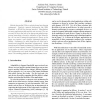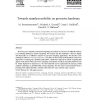PERCOM
2005
ACM
15 years 2 months ago
2005
ACM
There is a huge effort in ongoing research on new middleware platforms and new distributed services to support ubiquitous environments and pervasive applications. Most research pr...
PERCOM
2005
ACM
15 years 2 months ago
2005
ACM
Context-aware pervasive-computing applications require continuous monitoring of their physical and computational environment to make appropriate adaptation decisions in time. The ...
PERCOM
2005
ACM
15 years 2 months ago
2005
ACM
This paper investigates a real-world problem termed "Bluetooth (BTH) pollution", which is expected to become commonplace as the mass deployment of BTH devices continues....
PERCOM
2005
ACM
15 years 2 months ago
2005
ACM
The Gaia ubiquitous computing platform currently supports mobile devices through a thin client proxy architecture. Mobile devices run a lightweight proxy client written in J2ME to...
PERCOM
2005
ACM
15 years 2 months ago
2005
ACM
WLAN location estimation based on 802.11 signal strength is becoming increasingly prevalent in today's pervasive computing applications. As alternative to the wellestablished...
PERCOM
2005
ACM
15 years 2 months ago
2005
ACM
The Session Initiation Protocol (SIP) has been widely adopted for Instant Messaging (IM) and VoIP telephony both by the enterprise and in service provider systems. Till now, SIP f...
PERCOM
2005
ACM
15 years 2 months ago
2005
ACM
Mobile devices like PDAs or mobile phones have become widespread. Similarly, network functionality like GSM, Bluetooth, or WLAN has become standard. Nevertheless, not many applica...
PERCOM
2005
ACM
15 years 2 months ago
2005
ACM
Preserving one's uniquely customized computing environment as one moves to different locations is an enduring challenge in mobile computing. We examine why this capability is...
PERCOM
2005
ACM
15 years 2 months ago
2005
ACM
PERCOM
2005
ACM
15 years 2 months ago
2005
ACM
There is a recent trend toward rule-based authorization systems to achieve flexible security policies. Also, new sensing technologies in pervasive computing make it possible to de...






